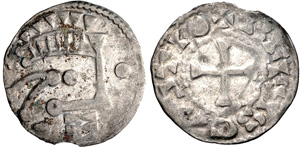
PREV ARTICLE
NEXT ARTICLE
FULL ISSUE
PREV FULL ISSUE
VIEWING COINS OBLIQUELYMike Marotta submitted this commentary which could literally change the way you look at coins. Thanks! -Editor
In the previous issue of The E-Sylum Dick Johnson made an off-hand comment about the correct orientation of a coin or medal. “The Mussolini token illustration in last week’s E-Sylum, which Editor Wayne stated was intact and could not be oriented correctly, brought to mind the task of orientation. The human mind craves correct visual perspective, everything on the level.” Allow me to point out that in fact, “correct” orientation is learned from your cultural context and is not inherent to the human mind. Numismatics offers many counter-examples. About 15 years ago, Geraldine Chimirri-Russell discovered that some issues of Celtic coins, which to us seem “Picasso-like” orient to correct 3-dimensional presentations of the human face when viewed at an angle. I attended a conference where she made this announcement ahead of her publications. Since then, her work has been reproduced and been cited by others. See for example, Money for Trade: A New View of Icenian Coinage by John Talbot (Oxford: Oxbow Books, 2017). Preparing an article for the now-defunct Celator about the great fairs of Champagne in the Middle Ages (whence the “troy” actually Troyez ounce of precious metal), I found coins struck over a thousand years later that still exhibited that orientation. According to Chimirri-Russell, we only learned to accept the front-on view with vanishing-point perspective as a result of Renaissance painting. Chimirri-Russell wrote: “The highly stylized images on Celtic coins feature human profiles with dissociated features. The coins have been viewed as two-dimensional works, however, if the coins are perceived as three-dimensional objects that can be freely rotated in space, their properties can be interpreted equally freely. When viewed from an oblique angle, the dissociated facial features can be seen to realign producing a three-dimensional, realistic face seen from a three-quarter, rather than profile view. This optical illusion is found on the majority of examples of extant coins, thus indicating intent on the part of the Celtic artists. Other works in metal produced by the Celts indicate that the rotation of the object to reveal or transform images of hidden faces and animals was expected.” See: “Taking an Oblique Point of View: The Challenges of Interpretation and Display in Museums,” The International Journal of the Humanities, Volume 5, Issue 12, pp.115-126, available at http://geraldineechimirri-russell.cgpublisher.com/product/pub.26/prod.1281 .  Classical Numismatic Group > Electronic Auction 413 FRANCE, Provincial. Blois (Comté). temp. Thibaut III. Circa 1037-1089/90. AR Denier (20mm, 1.10 g, 5h). Stylized Blois-style head right; pellet to right / + BEISIS C?STIO, cross pattée. Duplessy, Féodales 578; Legros 968; Poey d'Avant 1690; Roberts 5056. VF, lightly toned. This illustration may help. -Editor
 Mike adds: Note that the above illustration from p92 in the Iceni book is from a Sassanian coin. This was not limited to the Celts. It shows how peculiar our orthogonal views may be. Here is a BNS newsletter that cites her presentation in 2004: To read the earlier E-Sylum article, see:  Wayne Homren, Editor The Numismatic Bibliomania Society is a non-profit organization promoting numismatic literature. See our web site at coinbooks.org. To submit items for publication in The E-Sylum, write to the Editor at this address: whomren@gmail.com To subscribe go to: https://my.binhost.com/lists/listinfo/esylum All Rights Reserved. NBS Home Page Contact the NBS webmaster 
|